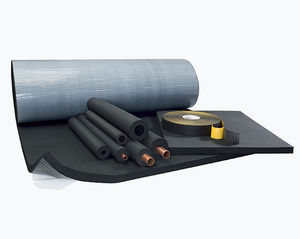Carefully Selected Insulation is Critical to the Efficiency and Longevity of a Refrigeration System
 Condensation control and process control are two major reasons for insulating low temperature systems such as refrigeration or cold chain transportation. These types of system’s temperatures range from -100°F to 31°F and are usually found in supermarkets, food processing, and transportation environments. When operating at such low temperatures, moisture in the air will condense or freeze on or within the insulation or cold pipe surface. Unless the system is protected by sufficient thickness and adequate vapor retarders, insulation can become wet, causing corrosion, which in turn causes it to become ineffective.
Condensation control and process control are two major reasons for insulating low temperature systems such as refrigeration or cold chain transportation. These types of system’s temperatures range from -100°F to 31°F and are usually found in supermarkets, food processing, and transportation environments. When operating at such low temperatures, moisture in the air will condense or freeze on or within the insulation or cold pipe surface. Unless the system is protected by sufficient thickness and adequate vapor retarders, insulation can become wet, causing corrosion, which in turn causes it to become ineffective.
Reasons to Insulate Your System
Refrigeration systems place many physical demands on insulation materials, one being moisture control. If moisture intrudes the insulating material surrounding refrigeration piping, thermal efficiency is lost. For most insulation products, an effective vapor retarder system is needed to restrict moisture migration through the facing, joints, seams, and supports. Sufficient insulation thickness is also needed to keep the surface temperature above the highest possible design dewpoint temperature of the ambient air so condensation does not form on the surface. Did you know that for every 1% in moisture gain, there is a 7.5% loss in thermal efficiency? Even a single percent increase in moisture will equate to a 7.5% increase in thermal conductivity (Thermal k)!
When insulation loses its ability to insulate, energy is lost and the equipment must work harder to maintain the desired chilling level. In a refrigeration system, this condition leads to energy loss, higher operating costs and the presence of moisture which can cause mold and mildew.
Benefits of Controlling Condensation in Your System
- Prevent the degradation of service life and performance
- Avoid mold growth
- Reduce the likelihood of corrosion on pipes, valves and fittings
There’s a reason why closed cell elastomeric foam is the best solution for refrigeration applications.
 Selecting closed-cell elastomeric foam insulation, like ArmaFlex®, is the most effective means of providing condensation control within an insulation system on refrigerant piping, drains and ducts. With a water vapor permeability of 0.050, ArmaFlex is nearly water-proof and does not require an additional vapor retarder. Not only does closed-cell foam insulation possess a low permeability rating, but it is also much less vulnerable to punctures and tears that can impair the thermal effectiveness of open cell and fibrous materials. Its smooth, flexible surface also fits tightly against the equipment, allowing close-fitting joint seams and termination points, preventing openings where condensation might form.
Selecting closed-cell elastomeric foam insulation, like ArmaFlex®, is the most effective means of providing condensation control within an insulation system on refrigerant piping, drains and ducts. With a water vapor permeability of 0.050, ArmaFlex is nearly water-proof and does not require an additional vapor retarder. Not only does closed-cell foam insulation possess a low permeability rating, but it is also much less vulnerable to punctures and tears that can impair the thermal effectiveness of open cell and fibrous materials. Its smooth, flexible surface also fits tightly against the equipment, allowing close-fitting joint seams and termination points, preventing openings where condensation might form.
